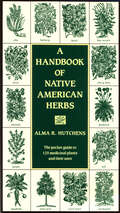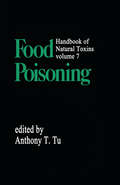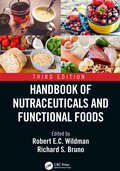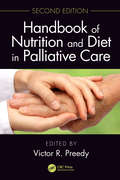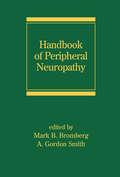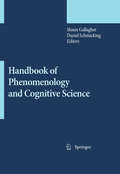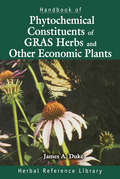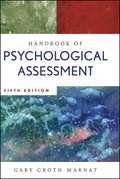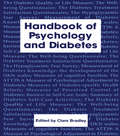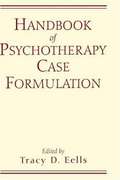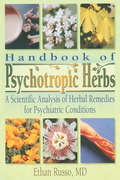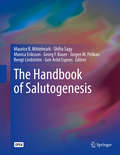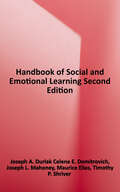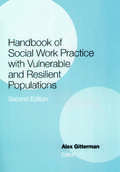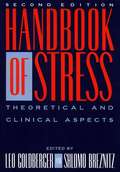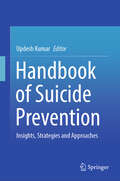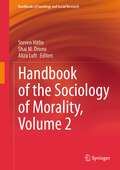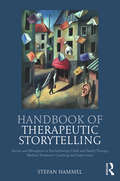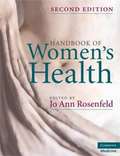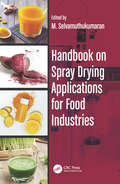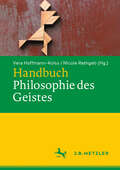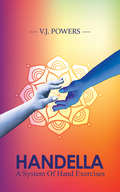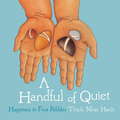- Table View
- List View
A Handbook of Native American Herbs: The Pocket Guide to 125 Medicinal Plants and Their Uses
by Alma R. HutchensThis authoritative guide--based on the author's classic reference work, Indian Herbalogy of North America--is a portable illustrated companion for the professional and amateur herbalist alike. It provides detailed descriptions of 125 of the most useful medicinal plants commonly found in North America, along with directions for a range of uses, remedies for common ailments, and notes on the herbal traditions of other lands. Entries include staples of folk medicine such as echinacea and slippery elm as well as common kitchen herbs--such as parsley, thyme, and pepper--whose tonic and healing properties are less widely known.
Handbook of Natural Toxins: Food Poisoning
by Anthony T. TuThis resource discusses all aspects of food poisoning and its sources such as bacteria, plant, and fungus - presenting the pathogens and food toxins in detail. Featuring contributions from over 30 leading authorities in the field, Food Poisoning ...: describes bacterial food contaminants including staphylococcal, salmonellae, E. coli, Clostridium perfringens, Bacillus cereus, cholera, and botulism; covers the prevention and treatment of mushroom and other poisonings from grains and plant-type foods; explains how to aid allergic reactions resulting from eating certain foods; identifies which kinds of seafood may cause severe poisoning; explores teratogenic aspects of food poisoning, outlining which foods pregnant women should avoid; and shows how those sensitive to nitrosamines can avoid such food poisoning.;Extensively referenced with more than 2200 literature citations, Volume 7: Food Poisoning serves as essential reading for toxicologists, microbiologists, dietitians and nutritionists, public health officials, food scientists and technologists, agricultural chemists and biochemists, bacteriologists, and graduate-level students in food science and toxicology.
Handbook of Nutraceuticals and Functional Foods
by Robert E.C. Wildman and Richard S. BrunoThe field of functional foods along with their bioactive food components has grown tremendously over the past decades. Often guided by hypothesis-generating epidemiological observations, discoveries from basic science studies and controlled trials in humans have provided critical evidence to help establish an optimal diet that alleviates chronic disease risk. These advances have also driven efforts by the food and nutraceutical industries to establish and market health claims, formulate extra-value foods, and even generate new health foods for human benefit.Handbook of Nutraceuticals and Functional Foods, Third Edition, compiles the data from experts in the field that potentiates the already established credibility of the earlier editions. In its three-section format, it provides an authoritative summary of the prophylactic and/or medicinal benefits of natural foods and their constituents that are linked to favorable health outcomes. Beginning with an overview of the field and associated regulations, each chapter describes the chemical properties, bioactivities, dietary sources, and evidence of these health-promoting dietary constituents.Features:• Summarizes plant- and animal-based functional foods and their bioactive components• New chapters on cannabidiol and scientific, legal, and regulatory considerations; green tea and nutraceutical applications; and herbal nutraceuticals and insulin resistance• Includes information on functional food beverages including coffee, green tea, and dairy milk• Discusses antioxidant and anti-inflammatory activities of vitamin E, anthocyanins and other (poly)phenolic compounds, and carotenoids• Provides an update on the health benefits and requirements of protein and performance and therapeutic application and safety of creatine.
Handbook of Nutrition and Diet in Palliative Care, Second Edition
by Victor R. PreedyHandbook of Nutrition and Diet in Palliative Care, Second Edition, is a comprehensive guide, providing exhaustive information on nutrition and diet in terminal and palliative care. It covers physical, cultural and ethical aspects, bridging the intellectual divide in being suitable for novices and experts alike. Following in the tradition of its predecessor, chapters contain practical methods, techniques, and guidelines along with a section on applications to other areas of palliative care. Each chapter features key facts highlighting important areas, summary points, and ethical issues. FEATURES • Use of cannabinoids in palliative nutrition care • Pain control in palliative care • Communications in palliative/end-of-life care: aspects of bad news • Anorexia in cancer: appetite, physiology, and beyond • Palliative care in severe and enduring eating disorders • Linking food supplementation and palliative care in HIV • Eating-related distress in terminally ill cancer patients and their family members • Palliative care of gastroparesis • Preoperative nutrition assessment and optimization in the cancer patient • Childhood leukemia, malnutrition, and mortality as components of palliative care • End-of-life decisions in persons with neurodevelopmental disorders • Resources: listing web sites, journals, books and organizations
Handbook of Peripheral Neuropathy (Neurological Disease and Therapy)
by Mark B. Bromberg A. Gordon SmithProviding a detailed study of the anatomy, physiology, and pathology of peripheral nerves, this reference provides a clear approach to the evaluation, characterization, and treatment of peripheral neuropathies-reviewing each major class of these disorders with authoritative discussions of clinical characteristics, electrodiagnostic features, examin
Handbook of Phenomenology and Cognitive Science
by Daniel Schmicking Shaun GallagherThe idea that phenomenology, in the European tradition, has something to offer the cognitive sciences is a recent development. Here, leading researchers address topics that lie at the intersection between phenomenological studies and the cognitive sciences.
Handbook of Phytochemical Constituent Grass, Herbs and Other Economic Plants: Herbal Reference Library (Herbal Reference Library)
by James A. DukeCRC Handbook of Phytochemical Constituents of GRAS Herbs and Other Economic Plants is a unique catalog that includes more than 15,000 phytochemical constituents from over 1,000 higher plant species. This volume covers all of the generally-recognized-as-safe (GRAS) herbs and at least 250 important food and medicinal plants. Each entry features the scientific name, one or more common names, a listing of phytochemical constituents, a single datum or range of quantitative data (wet-weight to dry-weight in parts per million), two-letter abbreviation identifying the plant part, and three-letter abbreviation(s) indicating the source(s) of the data. The extraordinary amount of data compiled into an easy-to-use tabular format makes the CRC Handbook of Phytochemical Constituents of GRAS Herbs and Other Economic Plants a volume useful to all pharmacologists, toxicologists, nutritionists, pharmacognicists, and food scientists.
Handbook of Psychological Assessment (5th Edition)
by Gary Groth-MarnatThis fifth edition reflects the more extensive use of psychological assessment for a wide variety of populations and the importance of working sensitively with diverse populations.
Handbook of Psychology and Diabetes: A Guide to Psychological Measurement in Diabetes Research and Practice
by Clare BradleyThis Handbook fulfils a pressing need within the area of psychological measurement in diabetes research and practice by providing access to material which has either been widely dispersed through the psychological and medical literature or has not previously been published. Journal articles describing the psychometric development of scales have rarely included the scales themselves but this book includes copies of scales and a wealth of additional information from unpublished theses, reports and recent manuscripts.You will find information about the reliability, validity, scoring, norms, and use of the measures in previous research presented in one volume.The Handbook is designed to help researchers and clinicians:· To select scales suitable for their purposes· To administer and score the scales correctly· To interpret the results appropriately.Dr. Clare Bradley is Reader in Health Psychology and Director of the Diabetes Research Group at Royal Holloway, University of London.Dr. Bradley and her research group have designed, developed and used a wide variety of measures of psychological processes and outcomes. Many of these measures have been designed and developed specifically for people with diabetes. Together with diabetes-specific psychological measures developed by other researchers internationally, these instruments have played an important part in facilitating patient-centred approaches to diabetes research and clinical practice.
Handbook of Psychophysiology (3rd Edition)
by Gary G. Berntson John T. Cacioppo Louis G. TassinaryThe Handbook of Psychophysiology, 3rd Edition is an essential reference for students, researchers, and professionals in the behavioral, cognitive, and biological sciences. Psychophysiological methods, paradigms, and theories offer entry to a biological cosmos that does not stop at skin's edge, and this essential reference is designed as a road map for explorers of this cosmos. The scope and coverage in the Handbook have expanded to include both a context for and coverage of the biological bases of cognitive, affective, social, and developmental processes and behavior. In addition to updated coverage of the traditional areas of psychophysiology, coverage of the brain and central nervous system has been expanded to include functional neuroimaging, event related brain potentials, electrophysiological source dipole localization, lesion methods, and transcranial magnetic stimulation. It also includes a section on cellular and humoral systems with attention to the communication across and interactions among cellular, immunological, endocrinological, and neural processes.
Handbook of Psychotherapy Case Formulation
by Tracy D. EellsPsychotherapy case formulation : history and current status / Tracy D. Eells -- The traditional psychoanalytic approach to case formulation / Stanley B. Messer, David L. Wolitzky -- The Core Conflictual Relationship Theme : a basic case formulation method / Lester Luborsky -- Cyclical maladaptive patterns : case formulation in Time-Limited Dynamic Psychotherapy / Hanna Levenson, Hans H. Strupp -- The Plan Formulation Method / John T. Curtis, George Silberschatz -- The Idiographic Conflict Formulation method / J. Christopher Perry -- Configurational Analysis : states of mind, person schemas, and the control of ideas and affect / Mardi J. Horowitz, Tracy D. Eells -- Case formulation in interpersonal psychotherapy of depression / John C. Markowitz, Holly A. Swartz -- Interpersonal case formulation : describing and explaining interpersonal patterns using the structural analysis of social behavior / William P. Henry -- Plan Analysis / Franz Caspar -- Case formulation in Cognitive Analytic Therapy / Anthony Ryle, Dawn Bennett -- Cognitive-Behavioral Case Formulation / Jacqueline B. Persons, Michael A. Tompkins -- Case formulation in Dialectical Behavior Therapy for borderline personality disorder / Kelly Koerner, Marsha M. Linehan -- Case formulation in behavior therapy : problem-solving and functional analytic strategies / Arthur M. Nezu ... [et al.] -- Case formulation in process-experiential therapy / Rhonda Goldman, Leslie S. Greenberg.
Handbook of Psychotropic Herbs: A Scientific Analysis of Herbal Remedies for Psychiatric Conditions
by Ethan B Russo Virginia M TylerDiscover herbal alternatives for the treatment of psychological disorders!Reliable and fact-filled, the Handbook of Psychotropic Herbs: A Scientific Analysis of Natural Treatments for Psychiatric Conditions offers psychiatrists, psychologists, counselors, physicians, and students in these fields a comprehensive review of the history, pharmacology, chemistry, and uses of medicinal herbs. A valuable resource for understanding today's unregulated herbal marketplace, this essential guide examines such herbs as ginkgo, ginseng, kava kava, linden, German chamomile, St. John's wort, and valerian, among others. The Handbook of Psychotropic Herbs will help you make a well-informed decision on what herbal treatments may be effective and safe for patients, or for you!Figures show that 30 percent of American adults use herbs. The Handbook of Psychotropic Herbs investigates the medical value of over 30 well-known herbs through in-depth evaluations that will give you a fuller understanding of the uses and misuses of these natural remedies. This invaluable guide examines the history, use, and research findings of each herb. The Handbook of Psychotropic Herbs lists the effectiveness of each herb, guidelines for its use, and any precautions you need to be aware of, and also includes the author's recommendations on approved dosages. Containing cutting-edge information about herbal medicine, the Handbook of Psychotropic Herbs will assist readers in making intelligent choices about buying and using herbs.Some of the herbs discussed in this reliable and fact-filled book include: California poppy Chinese and American ginseng kava linden German and Roman chamomile St. John's wort lavender damiana passion flower plus many more!The Handbook of Psychotropic Herbs contains the history, use, phytochemistry, laboratory and clinical studies, and consumer and physician information for each of these widely-used herbs. This important book will help you better understand the role of plants in human psychopathophysiology and its treatment, enlightening you about alternative and proven herbal options for medical care. A Behavioral Science Book Club Main Selection!
The Handbook of Salutogenesis
by Maurice B. Mittelmark Shifra Sagy Monica Eriksson Georg F. Bauer Jürgen M. Pelikan Bengt Lindström Geir Arild EspnesThis in-depth survey of salutogenesis shows the breadth andstrengths of this evolving specialty through diverse health promotion, healthcare, and wellness platforms. Background and historical chapters trace thedevelopment of the salutogenic model of health from other healing disciplinesand flesh out the central concepts, most notably generalized resistanceresources and the sense of coherence, that differentiate it from the others. Fromthere, experts describe a range of real-world applications within and outsidehealth contexts, from positive psychology to geriatrics, from small towns tocorrections facilities, and from school and workplace to professional training. Andperspectives from scholars in languages other than English show the globalrelevance of the field. Among the topics in the Handbook: · Emerging ideas relevant to thesalutogenic model of health · Specific resistance resources in the salutogenicmodel of health · Thesense of coherence and its measurement · Theapplication of salutogenesis in communities and neighborhoods · Theapplication of salutogenesis to health development in youth with chronicconditions · Theapplication of salutogenesis in mental health care settings The Handbook ofSalutogenesis summarizes anincreasingly salient field for graduate and professional students of publichealth, nursing, psychology, and medicine, and for their instructors. It willalso appeal to health-related academicians and professionals who wish to have athorough grounding in the topic.
Handbook of Social and Emotional Learning, 2nd Edition
by Joseph A. Durlak Celene E. Domitrovich Joseph L. MahoneyThe definitive work on social and emotional learning (SEL) research and practice is now in an extensively revised second edition, featuring all new and thoroughly updated chapters. The world’s leading SEL scholars describe state-of-the-art interventions that build students' competencies for managing emotions, showing empathy for others, forming supportive relationships, and making responsible decisions. The scientific underpinnings of SEL are explored and its impact on academic achievement and behavior is examined. The Handbook discusses ways to assess SEL and design effective, developmentally and culturally informed programs for students in preschool through secondary school settings and beyond. New to This Edition *Reflects a decade of significant advances in research, policy, and implementation. *New and expanded topics--equity, culturally responsive practice, multi-tiered systems of support, adult SEL, technology tools and applications, mental health, scaling up successful interventions, and more. *Six chapters on international SEL efforts, discussing both developed and developing countries. *Every chapter concludes with Key Takeaway Points.
Handbook of Social Work Practice with Vulnerable and Resilient Populations (2nd Edition)
by Alex GittermanThe second edition of this how-to-guide has been updated to reflect the field's growing understanding of resiliency and protective factors and their importance in forming balanced assessments and interventions. Individual chapters explore methods of coping with such problems as physical illness, homelessness, divorce and abuse. This edition also includes new chapters on crime victims, the death of a parent, gays and lesbians, single parenthood, and women of color.
Handbook of Stress, 2nd Ed
by Leo Goldberger Shlomo Breznitz40 essays by specialists examine a variety of stress-related conditions. They cover the clinical, research and theoretical aspects of stress - the concept of stress, biological/psychological phenomena, treatment and support. New to this edition are chapters on AIDS, the burnout phenomenon, ageing, chronic illness, the aftermath of the Holocaust, psychosomatic disorders, biomedical indices of stress and sexual abuse. The chapters on personality, emotion, cognitive processes, depression, bereavement, work-stress, disaster, trauma, alcoholism, stress management and social suppport have been significantly revised.
Handbook of Suicide Prevention: Insights, Strategies and Approaches
by Updesh KumarThe Handbook of Suicide Prevention covers a broad range of topics related to suicidal behaviour, including its underlying causes, risk factors, prevention strategies, and therapeutic approaches. With contributions by renowned experts in the field, the volume brings forth the latest research and clinical insights into suicidal behaviour. It highlights evidence-based practices effective in reducing suicide risk. It provides a comprehensive overview of the multidimensional perspectives, including biological, psychological, and social factors contributing to suicidal ideation and behaviour. The book provides a nuanced and extensive understanding of how suicide risk and protective factors are shaped by social, cultural, and political contexts across the lifespan. The last section of the volume highlights the need for a multifaceted approach to suicide prevention by leveraging the latest technologies and therapeutic modalities while also addressing the social and cultural factors that contribute to suicide risk. Suicidal behaviour remains an intriguing phenomenon that demands addressing being among the leading causes of death worldwide. The handbook is a compilation of essential resources that offers a multitude of theoretical and compassionate approaches to understanding and addressing this complex phenomenon. Its practical guidance and evidence-based recommendations make it an essential reference for anyone working in suicide prevention, mental health and social work.
Handbook of the Sociology of Morality, Volume 2 (Handbooks of Sociology and Social Research)
by Steven Hitlin Shai M. Dromi Aliza LuftThis handbook articulates how sociology can re-engage its roots as the scientific study of human moral systems, actions, and interpretation. This second volume builds on the successful original volume published in 2010, which contributed to the initiation of a new section of the American Sociological Association (ASA), thus growing the field. This volume takes sociology back to its roots over a century ago, when morality was a central topic of work and governance. It engages scholars from across subfields in sociology, representing each section of the ASA, who each contribute a chapter on how their subfield connects to research on morality. This reference work appeals to broader readership than was envisaged for the first volume, as the relationship between sociology as a discipline and its origins in questions of morality is further renewed. The volume editors focus on three areas: the current state of the sociology of morality across a range of sociological subfields; taking a new look at some of the issues discussed in the first handbook, which are now relevant in sometimes completely new contexts; and reflecting on where the sociology of morality should go next. This is a must-read reference for students and scholars interested in topics of morality, ethics, altruism, religion, and spirituality from across the social science.
Handbook of Therapeutic Storytelling: Stories and Metaphors in Psychotherapy, Child and Family Therapy, Medical Treatment, Coaching and Supervision
by Stefan HammelThe Handbook of Therapeutic Storytelling enables people in the healing professions to utilise storytelling, pictures and metaphors as interventions to help their patients. Communicating in parallel worlds and using simple images and solutions can help to generate positive attitudes, which can then be nurtured and enhanced to great effect. Following an "Introduction" to the therapeutic use of stories, which closes with helpful "Instructions for use", the book is divided into two parts, both of which contain a series of easily accessible chapters. Part One includes stories with specific therapeutic applications linked to symptoms and situations. Part Two explains and investigates methods and offers a wide range of tools; these include trance inductions, adaptation hints, reframing, the use of metaphor and intervention techniques, how stories can be structured, and how to invent your own. The book also contains a detailed reference section with cross-referenced key words to help you find the story or tool that you need. With clear guidance on how stories can be applied to encourage positive change in people, groups and organisations, the Handbook of Therapeutic Storytelling is an essential resource for psychotherapists and other professions of health and social care in a range of different settings, as well as coaches, supervisors and management professionals.
Handbook of Women's Health
by Jo Ann RosenfeldThis practical handbook provides a clear and comprehensive evidence-based guide to the care of women in primary care, intended for general and family practitioners, nurses, physician assistants, and all those who practise primary care of women. It emphasizes preventive and well-woman care throughout the life-cycle of a woman, including sexuality, contraception, medical care in pregnancy, and psychological and important medical concerns. This new edition, revised and updated throughout with several new contributing authors, incorporates the latest evidence and research-findings on a wide range of problems for which women seek medical guidance. There is an expanded section on menstrual problems and menopause-associated conditions, including clear guidance on the use of hormone replacement therapy.
Handbook on Spray Drying Applications for Food Industries
by M. SelvamuthukumaranSpray drying is a mechanical process by which materials in liquid form can be converted into solid form such as powders. It is a rapid, continuous, cost-effective, reproducible and scalable process for producing dry powders from a fluid material by atomization through an atomizer into a hot drying gas medium, usually air. The Handbook on Spray Drying Applications for Food Industries deals with recent techniques adopted in spray drying systems for drying a vast array of food products, novel and emerging tools used for spray drying of antioxidant rich products, optimized conditions used for extraction and production of herbal powders by using spray drying techniques, and problems encountered during spray drying of acid and sugar rich foods and also various herbal powders. The book discusses the encapsulation of flavors by using the spray drying process providing a comparison with other encapsulation techniques. It reviews the retention of bioactive compounds and the effect of different parameters on bioactive compounds during spray drying of juice. Moreover, the book explains the effect of novel approaches of spray drying on nutrients. The book addresses strategies adopted for retention of nutrients and survival of probiotic bacteria during spray drying processing. It also identifies packaging material needed for enhanced product stability. The safety and quality aspects of manufacturing spray dried food products are discussed. Key Features: Describes the design of high performance spray drying systems Highlights the strategy adopted for maximizing the yield potential of various spray dried food products Discusses strategies adopted for retention of nutrients and survival of probiotic bacteria during spray drying process Contains charts, procedure flow sheets, tables, figures, photos, and a list of spray drying equipment suppliers This book will benefit entrepreneurs, food scientists, academicians and students by providing in-depth knowledge about spray drying of foods for quality retention and also for efficient consumer acceptability of finished products.
Handbook to the Afterlife
by Pamela Rae Heath Jon KlimoIn Handbook to the Afterlife, two seasoned experts with decades of experience working with channeled material describe the stages that spirits go through, focusing on the details that these accounts have in common. Just as life itself has different stages of growth and development, so most accounts of the afterlife are consistent with the authors’ view that dying and rebirth are also continuous processes. Beginning with the moment of death itself, progressing through different transitional stages, and ending with the return of spirits to the physical plane, authors Pamela Heath and Jon Klimo define the purposes and pitfalls of each stage. They look at the kinds of adjustment problems that occur in each phase, and how spirits can be helped to move forward. Questions of pain and emotional state at the time of death, karma, and reincarnation are sensitively addressed. The book includes practical techniques for opening up communication with those who have passed on to the other side. While of interest to anyone seeking a general overview of the subject, Handbook to the Afterlife is particularly useful for those dealing with spirits who have not moved on, such as ghosts.
Handbuch Philosophie des Geistes
by Vera Hoffmann-Kolss Nicole RathgebWelchen Status haben mentale Zustände, wie bewusste Empfindungen, Wünsche, Überzeugungen oder Emotionen, in einer physikalischen Welt? Lassen sich alle derartigen Zustände auf Hirnzustände reduzieren? Was genau zeichnet mentale Zustände aus, und was können wir über die mentalen Zustände unserer Mitmenschen wissen? Dieses Handbuch liefert einen systematischen Überblick über Positionen und Fragestellungen in der Philosophie des Geistes. Ein zentrales Themengebiet ist dabei das Verhältnis zwischen mentalen Zuständen und Hirnzuständen: physikalistische und nicht-physikalistische Ansätze sowie das Problem der mentalen Verursachung. Darüber hinaus werden Fragestellungen zum Charakter des Mentalen und zu verschiedenen Typen mentaler Zustände in den Blick genommen, etwa die Debatten über Qualia, Intentionalität, Gedächtnis und das Verhältnis zwischen Denken und Sprache. Abgerundet wird das Bild durch Beiträge zum Thema Willensfreiheit, zur empirischen Erforschung mentaler Zustände sowie zu historischen Positionen in der Leib-Seele-Debatte.
Handella: A System of Hand Exercises
by V. J. PowersWe rely on our hands every day and can take for granted their strength, flexibility and dexterity. We exercise our bodies, faces and minds to maintain fitness and health but, until now, have not had a structured set of exercises specifically for our hands. The Handella system of hand exercises provides a comprehensive set of gentle movements to flex and stretch the muscles and joints in our hands. Including Warm Up, Work Out and Cool Down sections, plus a simple hand massage, this helpful book provides a simple set of exercises for people of all ages and abilities. Incorporating the benefits of hand reflexology, the Handella exercises help to increase and maintain manual flexibility and dexterity. Wave hello to happy hands with Handella - a mindful workout for the hands!
A Handful of Quiet: Happiness in Four Pebbles
by Thich Nhat HanhA Handful of Quiet presents one of the best known and most innovative meditation practices developed by Thich Nhat Hanh as part of the Plum Village community's practice with children. <P> Pebble meditation is a playful and fun activity that parents and educators can do with their children to introduce them to meditation. It is designed to involve children in a hands-on and creative way that touches on their interconnection with nature. Practicing pebble meditation can help relieve stress, increase concentration, nourish gratitude, and can help children deal with difficult emotions. A Handful of Quiet is a concrete activity that parents and educators can introduce to children in school settings, in their local communities or at home, in a way that is meaningful and inviting. Any adult wishing to plant seeds of peace, relaxation, and awareness in children will find this unique meditation guide helpful. Children can also enjoy doing pebble meditation on their own.Beautiful color illustrations by Wietske Vriezen, illustrator of Planting Seeds (ISBN-13: 978-1-935209-80-5) and Mindful Movements (978-1-888375-79-4).
